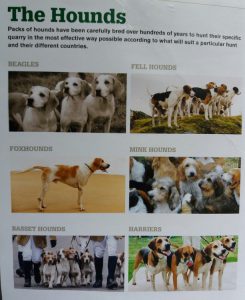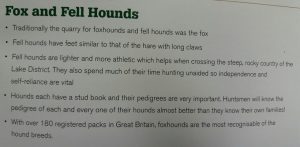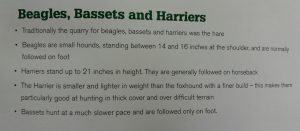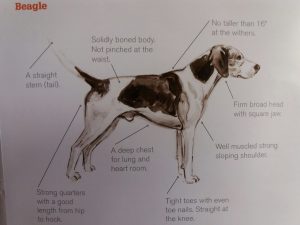Foxhounds
Information from the Masters of Foxhounds Association, pictures from the CA
“The British Isles consists of vastly different types of country and therefore hounds have evolved over time to suit different countries. Thus a different a sort of hound is required in the steep fell of the lake district (inaccessible to the horse) than in the hard riding fields of Leicestershire. However, hounds require some ‘generic’ qualities no matter what sort of country they are hunting as shown below:
Nose: Hounds hunt by following a scent rather than by sight
Stamina: Hounds hunt for many hours a day, two or sometimes three days per week
Cry: Cry or tongue is very important so that the hound can let other hounds (and the Huntsman and followers) that it has the scent
Pack sense: Hounds need to work as a pack and not become too independent
Speed: When foxhunting was allowed hounds needed to able to put pressure on the fox during a hunt
Drive: The ability to keep going forward and not to dwell on the line
Courage: To get back to the pack when separated, to enter thick cover and to kill his fox
Fox sense: Hard to explain but this is what makes certain hounds stand out from the others. Those who have it find and kill more foxes than others.
The Foxhound has been very carefully bred and in many cases pedigrees can be traced back to the early 1700’s, however the first volume of the Stud Book was not produced until 1841. The types of hounds mainly seen today are:
– The Modern Foxhound
– The Old English Foxhound
– The Fell Hound
– The Hill Hound
– The Welsh Hound
– The West Country Harrier
Most packs now hunt the Modern Foxhound but many have been bred using a judicious blending of Welsh blood. In some cases packs have out crossed to other types the most recent being the American.”
Harriers and Beagles
Information from the Association of Masters of Harriers and Beagles, pictures from the CA
“There are two different types of hound that have been bred over several centuries for their working qualities related to the hare. They are the harrier and the beagle. There are two distinct breeds of Harrier: the Stud Book Harrier and the West Country Harrier. The Stud Book Harrier is smaller and lighter than the West Country Harrier. Beagles stand between 14 and 16 inches and harriers stand up to 21 inches in height. The qualities of a working hound are:
Scenting ability / ‘nose’
Stamina – which depends on their conformation
Bidability – their willingness to work and live as a member of a pack in and out of kennels
Steadiness – that they are permitted to hunt hares and not other quarry
Intelligence – their ability to understand the wiles of the hare
Voice – which is the sign that they are hunting a hare – and only a hare
All hounds for hunting are bred in kennels and are registered annually by their name in their own Association Stud Book. Each hound is either ear-marked or ‘chipped’ so as to provide its positive identification. Hounds bred from those which are not recorded in the stud book may later be so recorded through an ‘appendix’ system.
The AMHB each year approves shows during the summer months at which registered hounds may be shown. They are judged for their conformation by approved judges: Hounds have been purposely bred to hunt. They are prepared for hunting in all conditions and over a variety of countries, with speed, ease of movement and stamina.
It is no coincidence that a hound which has speed, versatility and ease of movement would not only be a hound that would last many seasons hunting without illness or injury, but also excel in the show ring. A hound with good conformation will move easily and effortlessly. Alertness, bidability and intelligence are also factors which can influence the hound’s level of working and show ring success. Nose, a hound’s scenting ability, is also a factor of breeding but cannot be judged in the show ring.”






